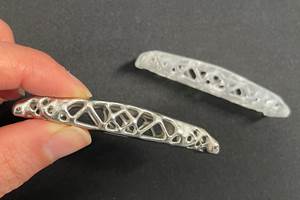New Generation Connector Finish
AMP develops a high-performance finish for its connector contacts...
If you drive any type of vehicle, call your office from a mobile telephone, watch the news on television or open the refrigerator looking for leftovers, you have probably connected with products manufactured by AMP Inc., Harrisburg, Pennsylvania. AMP (Aero-Marine Products) is a leading supplier of electrical and electronic connection devices, which include products from traditional connectors and tooling to cutting-edge technologies in fiber optics and wireless communications.
Recently, AMP took the wraps off a new plating finish material for its connector contacts, palladium/cobalt. AMP conducted studies indicating that contacts finished with palladium/cobalt provide better performance than palladium/nickel plated connectors at about the same cost.
According to Dr. James Sykes, director of AMP Global Technology, the company sees palladium/cobalt as the next generation of connector contact finishes. "We have been developing palladium/cobalt finishes at our manufacturing and research facilities for about two years," he said. "The work has involved developing and refining the formulation and process for applying the electroplating solutions." The technology was licensed from the electrochemical arm of Lucent Technologies.
AMP tests demonstrate that palladium/cobalt offers both performance and processing advantages over palladium/nickel, which has stood as the cost-effective finish of choice for about 20 years. "Palladium/cobalt has greater durability," Dr. Sykes said. "Hardness has a significant impact on durability; its hardness is greater than palladium/nickel or hardened gold. Durability is especially important for connectors that undergo numerous connect/disconnect cycles during their life span." Other performance parameters, such as contact resistance and fretting corrosion resistance, run about the same for the two alloys.
Another advantage concerns processing quality control. AMP experienced a higher degree of thickness control with palladium/cobalt, providing a smoother and more uniform finish. The connector contacts typically have a nickel barrier layer between the copper contact and the top-plate finishes. The nickel barrier layer prevents the copper from diffusing through the palladium to the surface. It also interferes with many thickness measurements of palladium/nickel. Thickness measurement of palladium/cobalt finishes do not suffer from this interference problem.
AMP plates the copper contacts of connectors to minimize corrosion and optimize electrical contact. Existing high-performance plating systems, in order of decreasing costs, are gold, palladium and palladium/nickel. In addition, a plated nickel layer always acts as a barrier between the copper contacts and the finish layer, preventing diffusion of the copper. A thin, one to five microinch, final layer of gold flash is generally recommended with all palladium systems.
Palladium, a noble metal, is less expensive to process than gold. However, during processing, palladium can absorb hydrogen from the plating baths. Because of this, localized brittle deposits form, leading to a tendency for cracks to develop in the contact surface. Palladium also reacts with carbon from the air to form an insulating polymer. This works well for an automotive exhaust system, but must be avoided for a connector contact.
Alloying palladium with nickel minimizes these problems, and reduces plating costs even further. Nickel makes the contact less noble and more prone to corrosion. The presence of nickel also complicates thickness measurements during processing. To offset thickness uncertainty, companies often plate more metal on the contacts than strictly necessary. Because of this, AMP and Lucent Technologies developed palladium/cobalt alloy plating.
Related Content
Nanotechnology Start-up Develops Gold Plating Replacement
Ag-Nano System LLC introduces a new method of electroplating based on golden silver nanoparticles aimed at replacing gold plating used in electrical circuits.
Read MorePossibilities From Electroplating 3D Printed Plastic Parts
Adding layers of nickel or copper to 3D printed polymer can impart desired properties such as electrical conductivity, EMI shielding, abrasion resistance and improved strength — approaching and even exceeding 3D printed metal, according to RePliForm.
Read MoreAn Overview of Electroless Nickel Plating
By definition, electroless plating is metal deposition by a controlled chemical reaction.
Read MoreHow to Maximize Nickel Plating Performance
The advantages of boric acid-free nickel plating include allowing manufacturers who utilize nickel plating to keep up the ever-changing regulatory policies and support sustainability efforts.
Read MoreRead Next
Education Bringing Cleaning to Machining
Debuting new speakers and cleaning technology content during this half-day workshop co-located with IMTS 2024.
Read MoreA ‘Clean’ Agenda Offers Unique Presentations in Chicago
The 2024 Parts Cleaning Conference, co-located with the International Manufacturing Technology Show, includes presentations by several speakers who are new to the conference and topics that have not been covered in past editions of this event.
Read MoreEpisode 45: An Interview with Chandler Mancuso, MacDermid Envio Solutions
Chandler Mancuso, technical director with MacDermid Envio discusses updating your wastewater treatment system and implementing materials recycling solutions to increase efficiencies, control costs and reduce environmental impact.
Read More





















